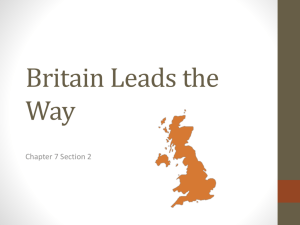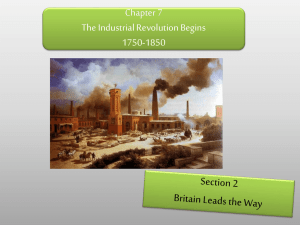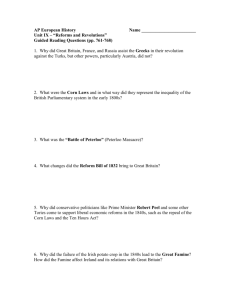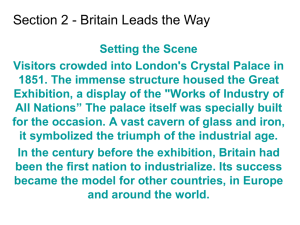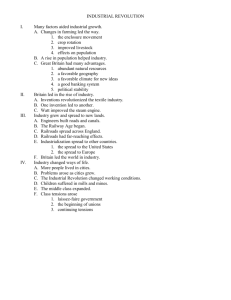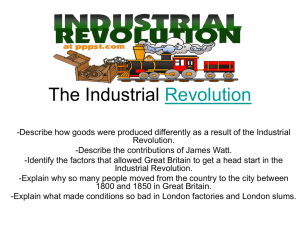Great Britain & the Industrial Revolution
advertisement
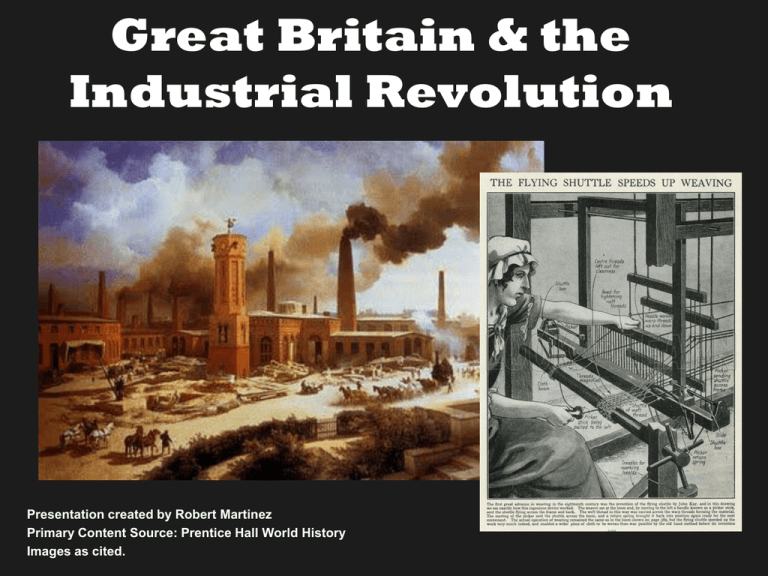
Great Britain & the Industrial Revolution Presentation created by Robert Martinez Primary Content Source: Prentice Hall World History Images as cited. Why did the Industrial Revolution begin in Britain? Historians have identified a number of key factors that helped Britain lead the way. industrialization-life.blogspot.com Britain was a small nation in size. However, it had large supplies of coal to power steam engines. It also had plentiful iron to build the new machines. In addition to natural resources, a labor supply was necessary. Large numbers of workers were needed to mine the coal and iron, build the factories, and run the machines. industryandchange.wordpress.com The agricultural revolution of the 1600 and 1700s freed many people in Britain from farm labor and led to a population boom. 19thhumanitiesschool.blogspot.com In the 1700s, Britain had plenty of skilled mechanics who were eager to meet the growing demand for new, practical inventions. Technology was an important part of the Industrial Revolution, but it did not cause it. After all, other societies, such as the ancient Greeks or Chinese, had advanced technology for their time but did not move on to industrialization. Only when other necessary conditions existed, including demand and capital, did technology pave the way for industrialization. edtech2.boisestate.edu From the mid-1600s to 1700s, trade from a growing overseas empire helped the British economy prosper. Beginning with the slave trade, the business class accumulated capital, or wealth to invest in enterprises such as shipping, mines, railroads, and factories. Many were ready to risk their capital in new ventures. www.carlisle.k12.ma.us At home, the population explosion boosted demand for goods. However, a growing population alone would not have resulted in increased production. General economic prosperity also helped make the new consumer goods affordable to members of every social class. www.gaire.com Britain had a stable government that supported economic growth. It built a strong navy to protect its empire and overseas trade. Although the upper class tended to look down on business people, it did not reject the wealth produced by the new entrepreneurs. www.antique-fine-art.com Religious attitudes also played a role. Many entrepreneurs came from religious groups that encouraged thrift and hard work. At the same time, many people focused more on worldly concerns than on the afterlife. Thus, risk takers such as inventors and bankers felt free to devote their energies to material achievements. www.geograph.org.uk The Industrial Revolution first took hold in Britain’s largest industry, textiles. In the 1600s, cotton cloth imported from India had become popular. British merchants tried to organize a cotton cloth industry at home. They developed the “putting-out” system, in which raw cotton was distributed to peasant families who spun it into thread and then wove the thread into cloth. Skilled artisans in the towns then finished and dyed the cloth. www.ehs.org.uk As the demand for cloth grew, inventors came up with a string of remarkable devices that revolutionized the British textile industry. For example, using John Kay’s flying shuttle, weavers worked so fast that they soon outpaced spinners. James Hargreaves solved that problem by producing the spinning jenny in 1764, which spun many threads at the same time. A few years later, Richard Arkwright invented the water frame, which used water power to speed up spinning still further. s3-eu-west-1.amazonaws.com The new machines doomed the “putting-out” system. They were too large and expensive to be operated at home. Instead, manufacturers built long sheds to house the machines. At first, they located the sheds near rapidly moving streams, which provided water power to run the machines. Later, machines were powered by steam engines. static.ddmcdn.com Spinners and weavers came each day to work in these first factories – places that brought together workers and machines to produce large quantities of goods. Early observers were awed at the size and output of these establishments. 270c81.medialib.glogster.com As production increased, entrepreneurs needed faster and cheaper methods of moving goods from place to place. Some capitalists invested in turnpikes, which were privately built roads that charged a fee to travelers who used them. Others had canals dug to link rivers or connect inland towns with coastal ports. Engineers also built stronger bridges and upgraded harbors to help the expanding overseas trade. upload.wikimedia.org The great revolution in transportation was the invention of the steam locomotive. It was this invention that made possible the growth of railroads. In the early 1800s, pioneers like George Stephenson developed steam-powered locomotives to pull carriages along iron rails. The railroad did not have to follow the course of a river. This meant that tracks could go places rivers did not, allowing factory owners and merchants to ship goods over land. www.travelcentre.com.au The world’s first major rail line, from Liverpool to Manchester, opened in England in 1830. In the following decades, railroad travel became faster and railroad building boomed. By 1870, rail lines crisscrossed Britain, Europe, and North America. upload.wikimedia.org Other inventors applied steam power to improve shipping. In 1807, and American, Robert Fulton, used Watt’s steam engine to power the Clermont up the Hudson River in New York. Fulton’s steamboat traveled at a record-breaking speed of more than five miles an hour… www.cardcow.com Designing steamships for ocean voyages was more difficult. The coal needed for the voyage took up much of the cargo space. But by the late 1800s, steam-powered freighters with iron hulls were carrying 10 to 20 times the cargo of older wooden ships. upload.wikimedia.org

